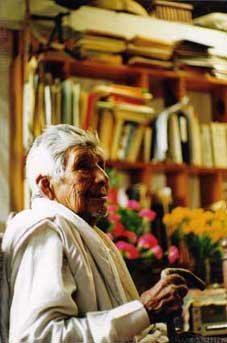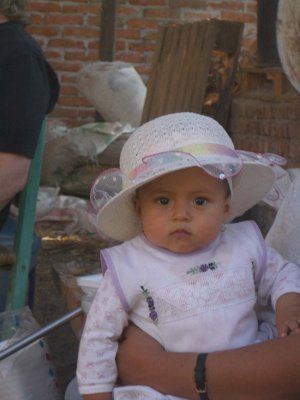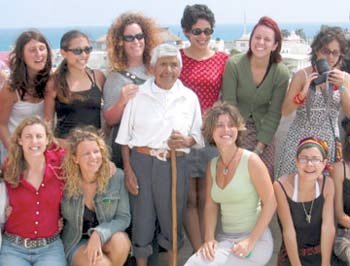


The Hundred Years Struggle of don Andrés
School of Authentic Journalism Professor and Co-Founder of Mexico’s Indigenous National Congress Reflects on His First Century
By Fernando León and Erin Rosa
Special to The Narco News Bulletin
December 9, 2010
 Don Andrés. Foto DR 1998 Al Giordano. |
At don Andrés’ house, a tiny, brick shack with dirt floors that is surrounded by corn fields, children, grandchildren, and great grandchildren sat at a table outside eating chicken and mole and talking about the head of the family. These days don Andrés’ is tackling the perils of being a century old. He can’t see, he can barely hear, he is bedridden, and admits that it’s likely he won’t be around for very much longer. Despite these difficulties, don Andrés is still conscious, and asks visitors for the most recent news relating to Mexico’s social movements and the country’s politics.
Though it’s debated whether the social leader was born before or after the Mexican Revolution began on November 20, 1910 (that he was born in that month is not in dispute) there’s no denying that don Andrés shares a unique role in the rich history of indigenous struggles in Mexico. For many years he was thought to be the last person who spoke Otomí-Nahñü, the language of his native people. However, Miguel Álvarez, a good friend at the party who met don Andrés in 1992, talked about a trip they once took to Tolimán in the state of Querétaro to seek help after a rattlesnake bit Andrés’ right arm.
 Doña Carolina Vázquez and don Andrés. Foto DR 2010 Erin Rosa. |
While doctors in hospitals had wanted to amputate the arm, don Andrés was able to save it by using a traditional indigenous medicinal practice he had learned from the Huichol ethnicity of spreading peyote on the wound. Five days later the swelling from the bite went away, according to Miguel. In the town, he was able to listen to residents speak in his native tongue. The emotion that he felt was indescribable, Miguel says. It had been numerous decades since he had stopped hearing it, and don Andrés had remembered that it was in the 1920s when is language stopped being heard so often.
 Andrea, great granddaughter of don Andrés. Foto DR 2010 Fernando León. |
“I won’t deny it, my life was no more than walking from here to there, attending to what was planted: red tomatoes, flowers, green tomatoes, and chiles,” said don Andrés while sitting on his bed. But don Andrés’ modesty is overshadowed by his life’s story, which ranges from battles during Mexican Revolution, to working on farms in the United States, to traveling with and supporting Zapatista communities in Chiapas, Mexico. In 1996, in his mid-80s, he founded and held the first Indigenous National Congress alongside Zapatista Comandanta Ramona, representing poor farmers and the indigenous struggle for autonomy. As the elder for of Indigenous National Congress he would continue to support the Zapatista cause. (Since 1997, Narco News publisher Al Giordano accompanied don Andrés in travels through more than a dozen states of the Mexican Republic, visiting the homes of leaders and elders of many of the country’s indigenous groups.)
 Don Andrés with students at the 2003 Narco News School of Authentic Journalism. Foto DR 2003 Noah Friedman-Rudovsky. |
Don Andrés’ life has involved “walking from here to there” where revolutionary movements were happening, including during the Mexican Revolution when citizens came together to topple dictator Porfirio Diaz. At the party, his friend Juan Balderas remembered that don Andrés once told him that during the 1915 Battle of Celaya, between the forces of Revolutionary hero Pancho Villa and Álvaro Obregón, the cannon blasts were so loud that the young Andrés begged his father to take him to a nearby mountain to watch the combat. With his pleas, the father had no choice but to bring his son to the mountain. Though the fighting could be seen clearly from there, it wasn’t enough for four-year-old Andrés, who again begged his father to take him to where the battle was taking place. Though his father refused, Andrés witnessed Villa’s victory from a mountain close to the town where he was born.
 Don Andrés and Narco News Publisher Al Giordano. Foto DR 2010 Fernando León. |
Now in 2010, a year where indigenous communities in Mexico continue to be marginalized by injustices from government and multinational companies, and when 20 percent of the population barely has enough money to afford food day by day, the struggles supported by don Andrés are more urgent than ever. It’s been 100 years since the Mexican Revolution and 100 years since don Andrés was brought into the world, and the indigenous leader remains a true auténtico, representing the character of those who struggle and those who work the land in Mexico. “If we don’t unite in order to achieve what we have been fighting for all these years, we will not get anywhere,” don Andrés told Narco News students in 2003. “Governments and important institutions are organized; so, we must also be organized.”
Lea Ud. el Artículo en Español
- The Fund for Authentic Journalism
For more Narco News, click here.




